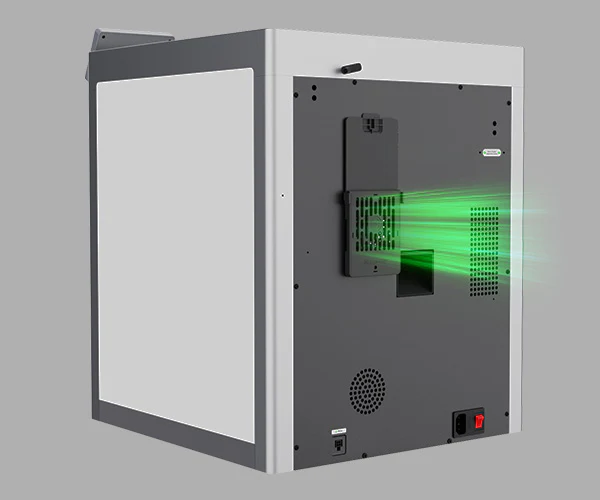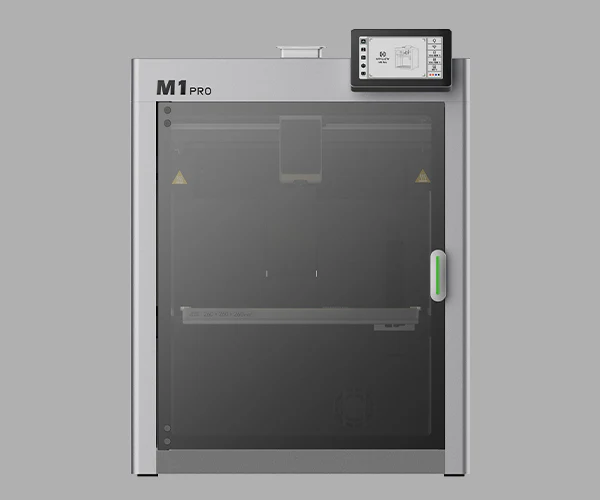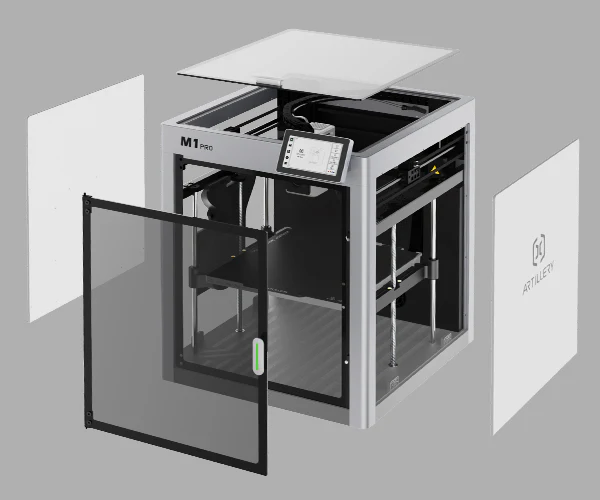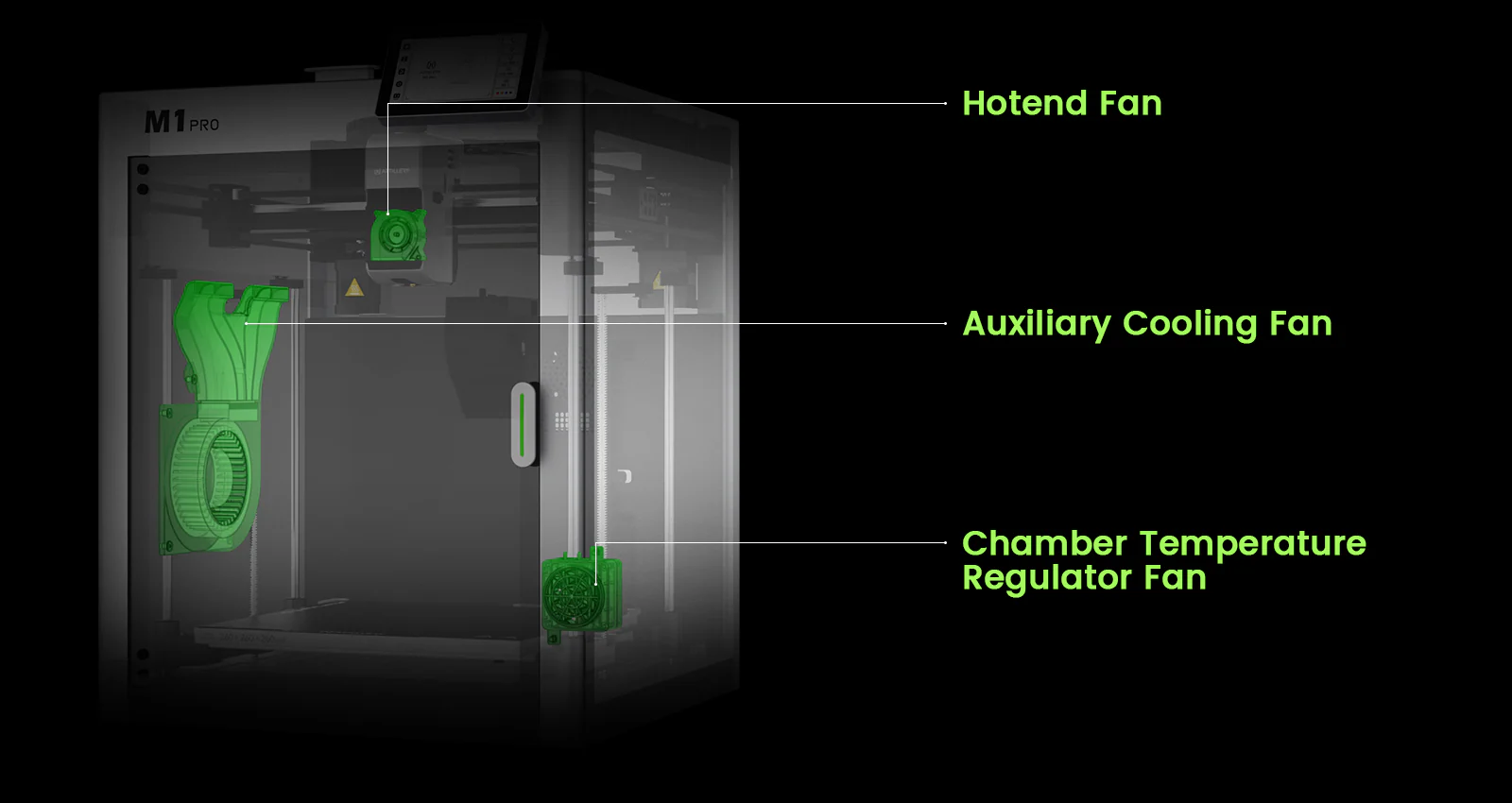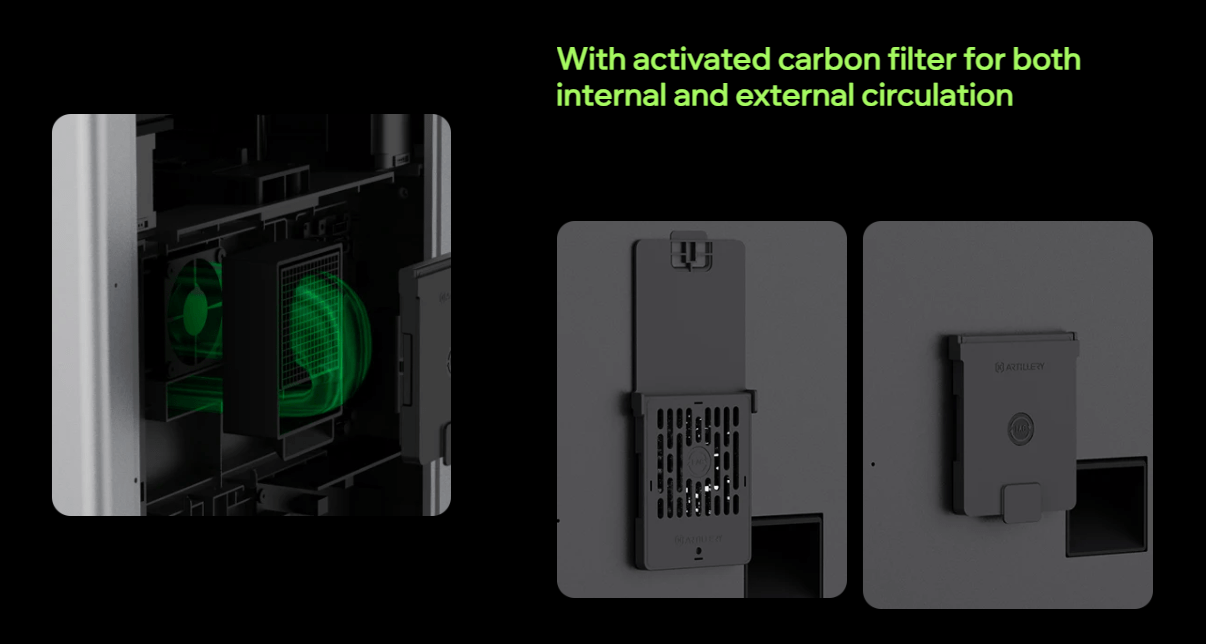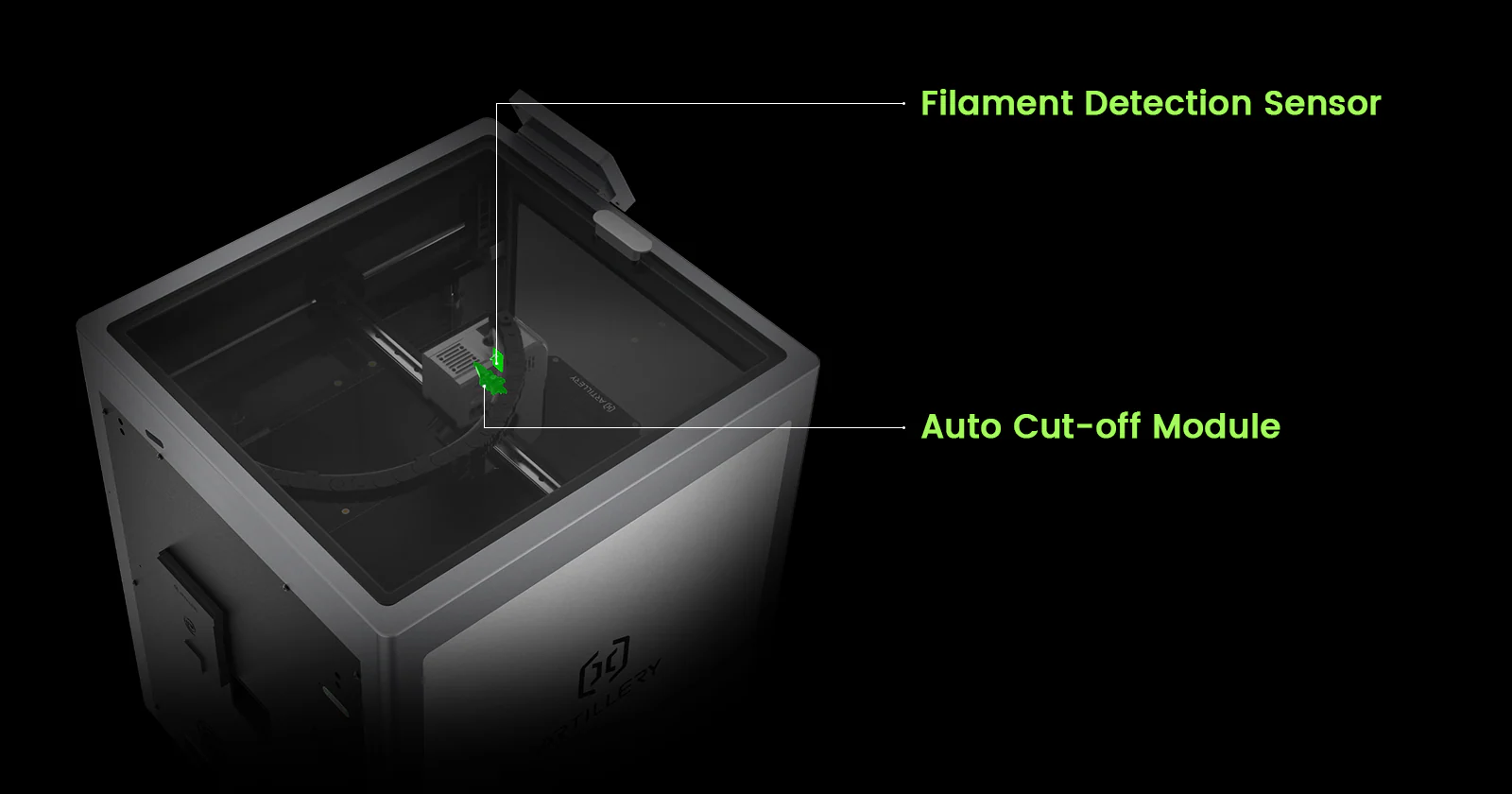Let’s be honest, the 3D printing world, especially the high-speed CoreXY segment, is absolutely buzzing right now. Artillery, a brand many of us know and trust for its reliable, spacious, open-frame printers, such as the Sidewinder series, is clearly shifting gears. They’re stepping into the ring with enclosed, performance-driven machines, and the Artillery M1 Pro feels like their knockout punch.
So, what makes this machine demand your attention? It’s aiming to be the ultimate all-rounder: picture a seriously spacious 300x300x400mm build volume, paired with speeds that genuinely make your jaw drop – we’re talking up to 600mm/s! But it doesn’t stop there. Crucially, it boasts the ability to handle tricky, high-temperature materials thanks to its integrated heated chamber.
In this review, we’re diving deep. We’ll put those impressive speed claims to the test, explore how user-friendly Klipper is on this platform, unpack its specialized features, and ultimately figure out if the M1 Pro hits that sweet spot for value. If you’re an ambitious hobbyist, someone wrestling with materials like ABS or Nylon, or a small business needing rapid, large-scale prototypes, keep reading – this printer might just be exactly what you’ve been waiting for.
Artillery M1 Pro is a Core XY 3D printer that pairs powerful performance, 260 × 260 × 260 mm build area, and up to 600 mm/s speed—with a built-in AI…
Related internal pages:
recommended printers for business
Explore the details
Design, Build Quality, and Volume
The Artillery M1 Pro is engineered with purpose; its design focuses on strength, precision, and speed. Every structural element is designed to support the CoreXY system and sustain flawless motion at extreme velocities.
CoreXY Architecture and Frame Rigidity
The M1 Pro’s CoreXY motion system is the key to achieving its 600 mm/s print speed. By keeping the bed stationary and minimizing moving mass, it reduces inertia and maintains accuracy during rapid accelerations of up to 20,000 mm/s².This precision is reinforced by a rigid, all-metal frame that absorbs vibration and maintains stability even under demanding print conditions. Despite its industrial-grade power, the printer maintains a compact, professional footprint.
Substantial Build Volume
But what’s the point of speed if you can’t print what you need? Happily, the M1 Pro doesn’t compromise on size, offering a genuinely substantial 300 x 300 x 400mm build volume. That’s plenty of room for large prototypes or multiple parts at once, easily eclipsing many smaller competitors.

Plus, that fully enclosed design isn’t just for show or noise reduction. Crucially, it’s essential for handling demanding, high-temperature materials like ABS, ASA, or Nylon. By maintaining a stable internal environment and keeping drafts out, it dramatically reduces warping and ensures those trickier filaments print reliably.
Smart. Simpler .

Every Print
Starts With Ease
Smart Watch, Easy Print
I fully automated start-up inspection Peace of mind every time you print Cabin debris scanning to ensure the cabin is free of foreign objects


AI intelligent monitoring system tracks extrusion status and instantly detects consumable extrusion faults.
Smart Loop Control
Unboxing & First Impressions
Packaging & Included Accessories
The Artillery M1 Pro arrives with the kind of professional packaging you’d expect from a flagship printer. Every component is securely fitted within dense foam, protecting it from transit shocks. Inside the box, everything is neatly organized—you’ll find a power cable, a set of spare nozzles, basic tools, a filament spool holder, and a quick-start guide to get you running smoothly. The presentation feels polished and purposeful, clearly reflecting Artillery’s attention to detail.
Factory-Assembled vs. Partial Kit: Time-to-First-Print
Unlike many CoreXY printers that demand extensive setup, the M1 Pro comes mostly pre-assembled. You’ll only need to mount a few components, such as the screen or spool holder, before printing. The on-screen Klipper interface makes the process almost effortless. With everything tuned at the factory, most users can expect to move from unboxing to their first print in under an hour, which is remarkably efficient for a high-speed machine.
Initial Quality Check: Frame Rigidity & Carriage Smoothness
Right out of the box, the build quality impresses. The all-metal frame feels rock-solid, with no wobble or flex during movement. The carriages glide along the linear rails with satisfying smoothness, showing careful alignment and tensioning. It’s immediately evident that Artillery put serious effort into precision engineering—every motion feels confident, stable, and ready for high-speed performance.
To Know More
Compare high-performance printers
Dare To Dream
Create With your Confidence
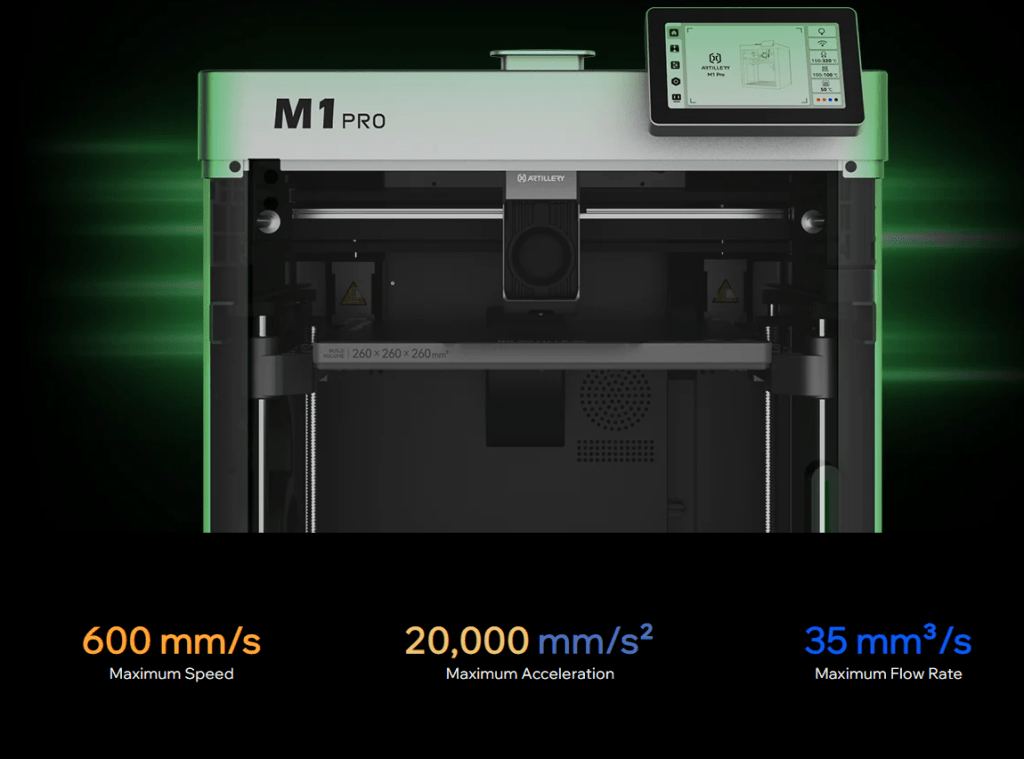
Performance Metrics: Speed and Material Capability
Pushing the Limits: 600mm/s with Klipper
The Artillery M1 Pro is built for speed, boasting Klipper firmware pre-installed and factory-tuned for peak performance. Features like Input Shaping and Pressure Advance minimize vibrations and maintain clean extrusion, even during rapid motion. While the printer can reach speeds of up to The Artillery M1 Pro simplifies setup with a true automatic bed leveling system, likely powered by a precision inductive or load-cell sensor. This ensures the nozzle maintains perfect distance across the entire print surface, allowing for reliable first-layer adhesion every time. It eliminates the need for manual adjustments—saving time while enhancing print consistency, particularly during extended production runs.
Additionally, the M1 Pro integrates vibration compensation technology, supported by built-in accelerometers similar to the ADXL345. These sensors fine-tune Input Shaper calibration across both the X and Y axes, reducing artifacts such as ringing or ghosting. The result is cleaner edges and smoother finishes, even when printing at full speed.600 mm/s, most users will find the optimal balance of speed and quality between 300–400 mm/s. Its lightweight Direct Drive Extruder and high-flow hotend ensure reliable filament flow, allowing for fast, detailed prints without quality loss.
High-Temperature and Engineering Filaments
Engineered for versatility, the M1 Pro’s 300°C all-metal hotend supports advanced filaments like Nylon, Polycarbonate, and carbon-fiber composites. The 60°C actively heated chamber maintains a stable environment, crucial for preventing warping and cracking when printing large parts in ABS or ASA. Together, these features make the M1 Pro a powerful choice for users needing both speed and true material flexibility.
Reliability and Advanced Features
Automated Setup and Calibration
The Artillery M1 Pro simplifies setup with a true automatic bed leveling system, likely powered by a precision inductive or load-cell sensor. This ensures the nozzle maintains perfect distance across the entire print surface, allowing for reliable first-layer adhesion every time. It eliminates the need for manual adjustments—saving time while enhancing print consistency, particularly during extended production runs.
Additionally, the M1 Pro integrates vibration compensation technology, supported by built-in accelerometers similar to the ADXL345. These sensors fine-tune Input Shaper calibration across both the X and Y axes, reducing artifacts such as ringing or ghosting. The result is cleaner edges and smoother finishes, even when printing at full speed.
H3: Safety and Air Management
Printing advanced materials like ABS or ASA inside an enclosure can get… smelly and particle-heavy. Artillery tackles this head-on with a smart HEPA and Activated Carbon filtration system. This diligently captures fine particles and neutralizes fumes, making your workspace significantly safer and more pleasant. Furthermore, a built-in camera allows you to monitor your print remotely, providing peace of mind and enabling you to catch potential issues before they escalate into disasters.
Artillery M1 Pro Technical Specifications
| Specification | Details |
|---|---|
| Printing Technology | FDM (Fused Deposition Modeling) |
| Build Volume | 300 × 300 × 400 mm |
| Printing Speed | Up to 600 mm/s |
| Acceleration | 20,000 mm/s² |
| Motion System | CoreXY Architecture |
| Frame Structure | All-Metal Enclosed Frame |
| Hotend Temperature | Up to 300°C |
| Heated Chamber | Active Heating up to 60°C |
| Build Plate | Flexible Magnetic PEI Plate (Heated) |
| Extruder Type | Lightweight Direct Drive, Dual-Gear System |
| Supported Filaments | PLA, PETG, ABS, ASA, Nylon, PC, Carbon Fiber Composites |
| Auto-Bed Leveling | 121-Point Fully Automatic Leveling System |
| Firmware | Klipper (Pre-Installed and Tuned) |
| Filtration System | HEPA + Activated Carbon Dual Filter |
| Connectivity | Wi-Fi, USB, LAN |
| Noise Level | Ultra-Quiet TMC2209 Drivers |
| Display | 4.3-inch Full-Color Touchscreen |
| Power Supply | AC 100–240V, 450W |
| Languages Supported | English, German, Chinese |
| Dimensions | 620 × 620 × 750 mm |
| Net Weight | ~22 kg |
Advanced components
enable superior durability.

Steel Dual-Gear Direct Drive
Heat-treated stainless steel gears ensure strong, precise grip on filament for smoother extrusion and superior print quality.
Hardened Steel Nozzle (55HRC)
Built for long-lasting durability and exceptional wear resistance, delivering consistent performance even with abrasive filaments.
Intelligent
Temperature Control
The M1 Pro features a 60°C actively heated chamber and a high-temperature hotend reaching up to 320°C, providing closed-loop temperature control. This helps reduce warping and deformation of high-performance materials, ensuring improved layer adhesion and maximizing their full potential.
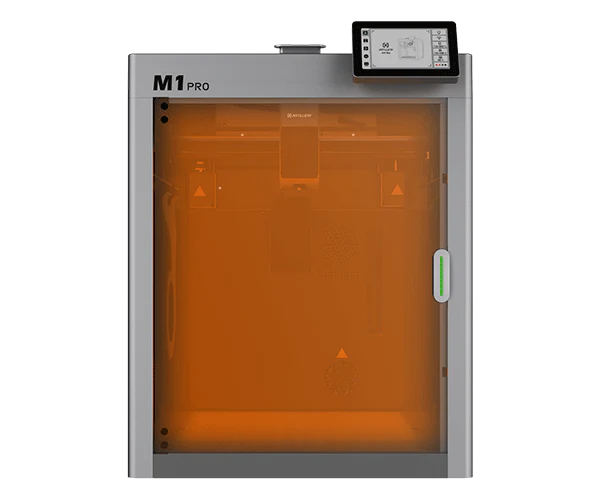
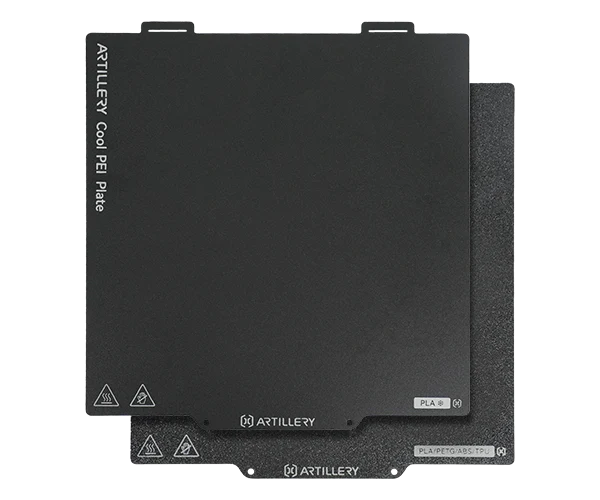
Dual-Sided
Flexible Plate
Precision in Motion,
Power in Performance
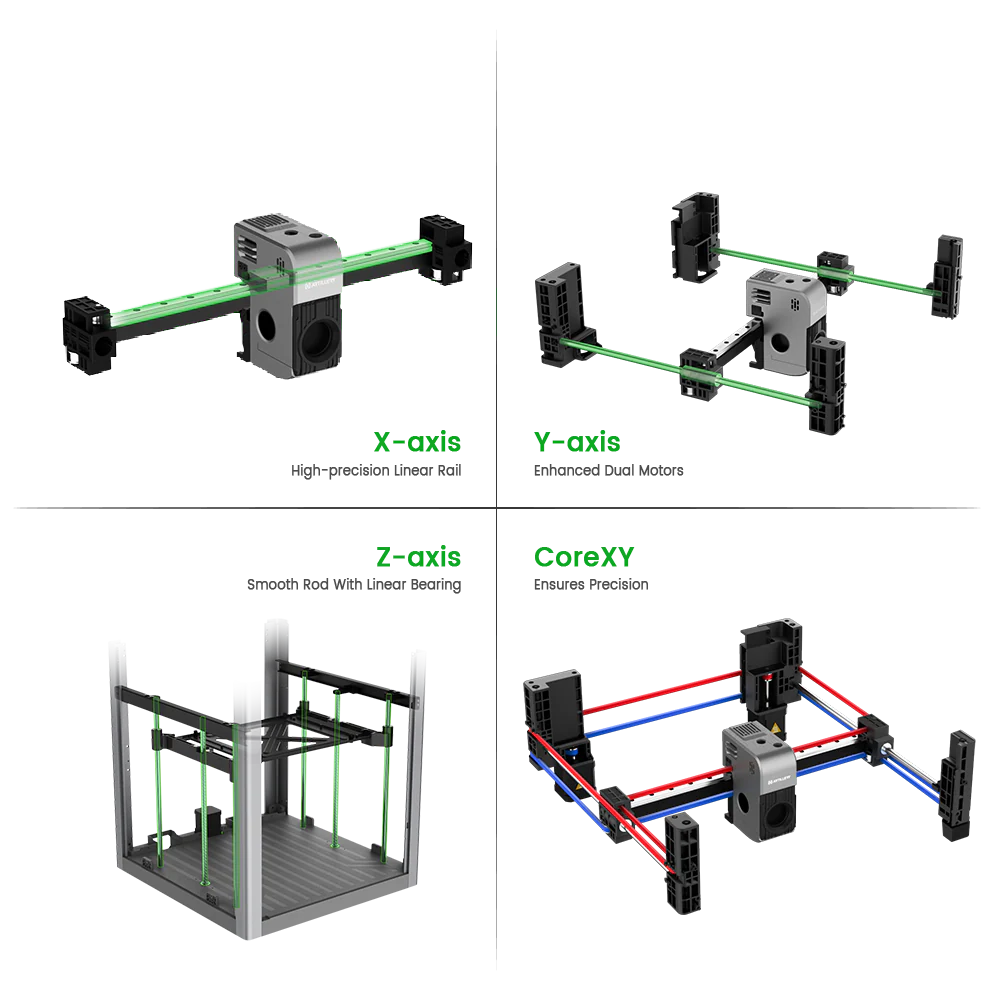
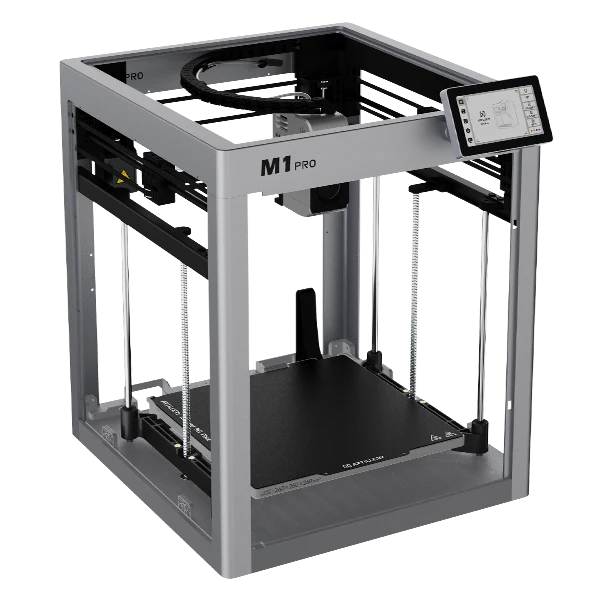
Monolithic Cast Aluminum Frame
Software Ecosystem and User Experience
Klipper UI and Customization
The Artillery M1 Pro offers a smooth and intuitive experience through its Klipper-based interface, which is powered by Mainsail or Fluidd. The 4.3-inch touchscreen is fast and responsive, making navigation effortless. Key functions such as filament loading, bed leveling, and tuning are neatly organized, allowing even first-time Klipper users to feel at ease.
For experienced users, the real strength lies in customization. The M1 Pro provides easy access to Klipper’s configuration files over the network, allowing you to fine-tune parameters such as acceleration, input shaping, and pressure advance. This open environment gives full control to those who enjoy optimizing performance for specific materials or workflows.
Connectivity and Workflow
When it comes to connectivity, the M1 Pro seamlessly supports Wi-Fi, LAN, and USB file transfers, offering flexible options for managing prints. Users can start, pause, or monitor tasks remotely through a web browser with minimal lag, which adds convenience to daily operations.

The printer also works flawlessly with popular slicers, including Cura, PrusaSlicer, and SuperSlicer, with Artillery-optimized profiles available right away. These presets simplify setup while maintaining top-tier results. Altogether, the M1 Pro’s software ecosystem strikes a balance between user-friendliness and full customization—perfect for anyone seeking both plug-and-play simplicity and advanced control.
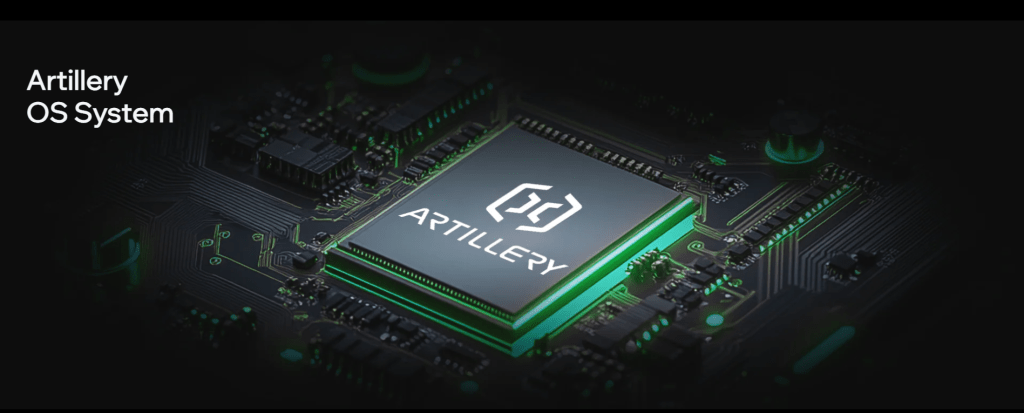
The Buying Decision
M1 Pro vs. M1 & M1 Carbon: Key feature comparisons
Artillery is definitely pushing boundaries, and the M1 Pro sits firmly at the top of their performance ladder. Think of it as their flagship model – it packs significantly more punch than their standard printers. We’re talking that crazy 600mm/s speed, a fully enclosed and heated chamber crucial for advanced materials, and Klipper integration right out of the box. If you’re after Artillery’s ultimate machine for demanding applications, the M1 Pro is clearly the one engineered for that leap.
M1 Pro vs. Competitors (Ender 3 V2, Anycubic Vyper): Price-to-performance
Against printers like the Ender 3 V2 and Anycubic Vyper, the M1 Pro may cost more, but it easily justifies its price. Those competitors reach around 200–250 mm/s in open‑frame setups, while the M1 Pro runs nearly three times faster—with better accuracy, quieter operation, and material flexibility. Its pre-tuned Klipper system, rigid frame, and high-temperature chamber make it a genuinely premium option for users who prioritize results over entry-level pricing.
9.3. Strengths & Weaknesses
| Strengths | Weaknesses |
|---|---|
|
|
Seamless Connectivity,
Effortless Control
With the M1 Pro, managing your prints has never been easier. Whether you have one printer or multiple, you can control them all from a single device. Enjoy Wifi transmission, SD card support, touchscreen operation, and pc software integration for a flexible and convenient printing experience, anytime, anywhere.

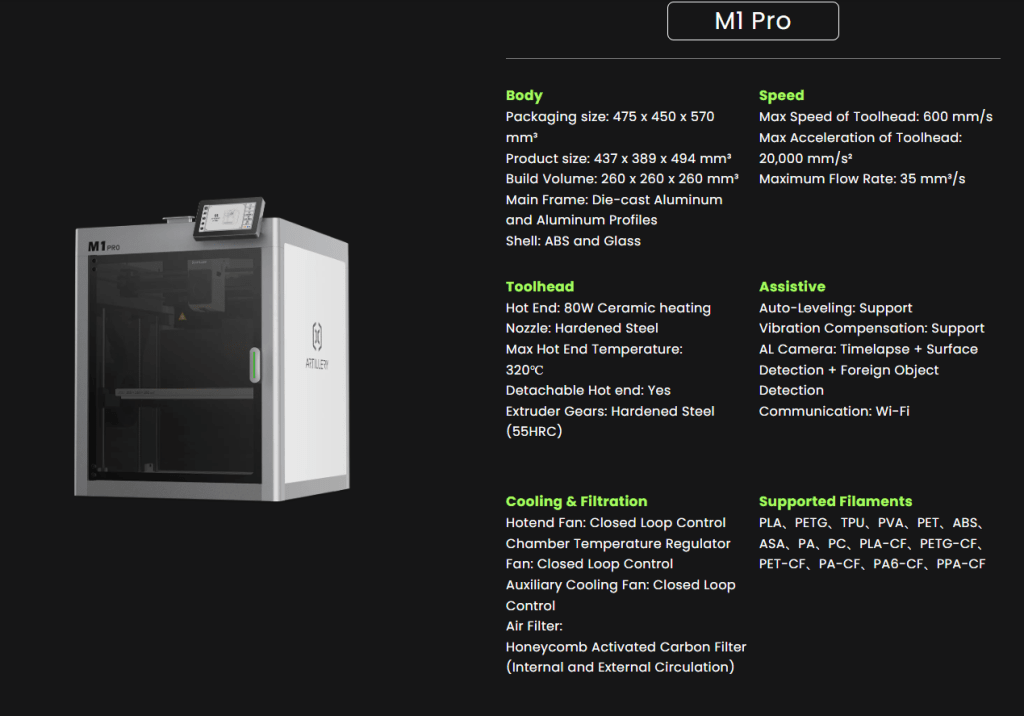
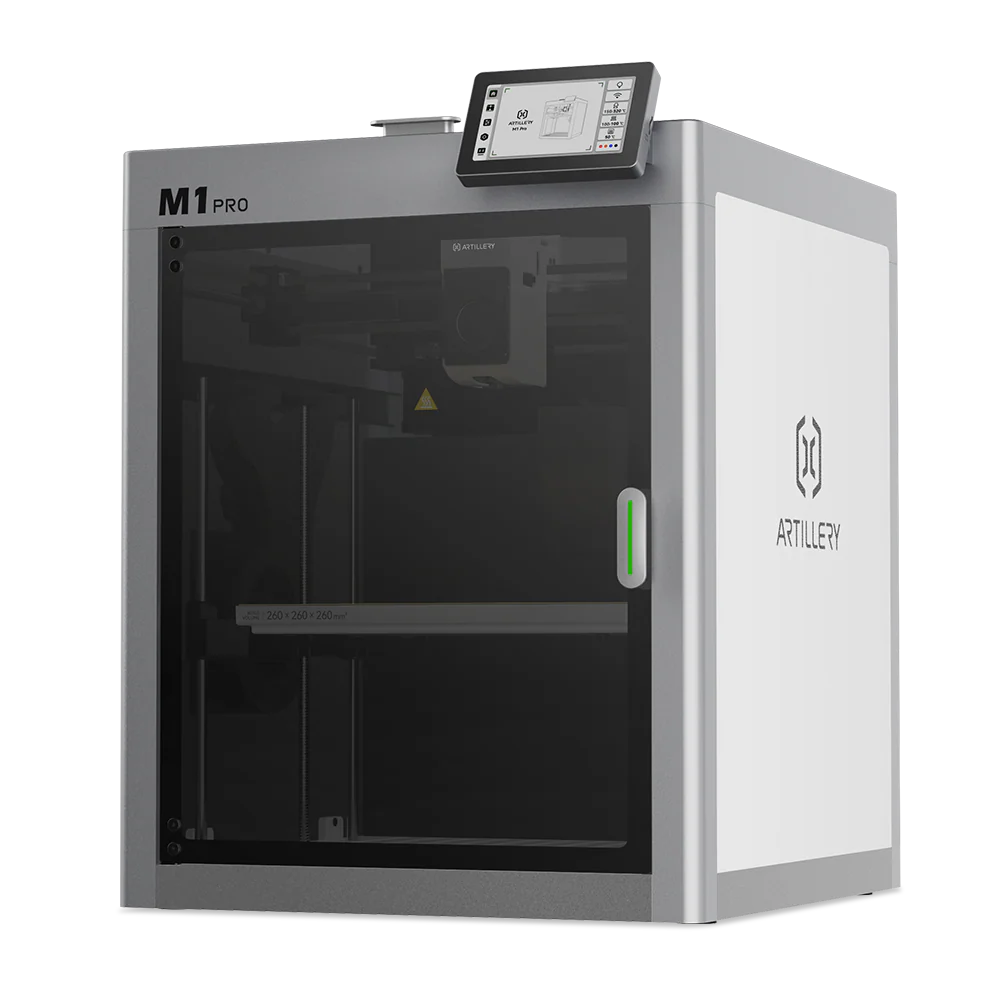
Click, Print, Create
No Hassle Required
Out of the box, no complicated assembly, no endless fine-tuning. With factory-calibrated precision and a robust, pre-assembled structure, you can start printing right away. Say goodbye to constant adjustments and enjoy a seamless experience from setup to high-quality prints.
FAQ
What is the build volume of the Artillery M1 Pro?
The build volume is 260 × 260 × 260 mm, offering a compact yet versatile space for prototypes, functional parts, or multiple smaller models, making it suitable for hobbyists and beginners without occupying too much desk space.
Is the Artillery M1 Pro a good choice for beginners, and how easy is setup?
Yes, it’s often recommended for beginners due to its quick out-of-the-box setup (under an hour following the quick start guide or unboxing video), intuitive 4.3-inch touchscreen, automatic bed leveling, and AI-assisted features like spaghetti detection. Users note it’s user-friendly with Artillery Slicer or Cura, but some advise watching tutorials for initial filament loading and calibration to avoid early hiccups.
What filaments does the Artillery M1 Pro support?
It supports a broad range of 1.75 mm filaments, including PLA, PETG, TPU, PVA, PET, ABS, ASA, PA, PC, and composites like PLA-CF, PETG-CF, PET-CF, PA-CF, PA6-CF, and PPA-CF, thanks to the 320°C all-metal hotend with hardened steel nozzle and direct-drive extruder. For ABS or ASA, the fully enclosed chamber helps maintain stable temperatures to prevent warping; however, users recommend using a filament dryer for moisture-sensitive materials like PETG or TPU.
How responsive is Artillery’s support?
Artillery provides technical support via email at support@artillery3d.com with a 24-hour response goal on working days. They also offer pre-sales consulting and have an active community for user support.
What are the key components and features?
| Component | Specification |
|---|---|
| Build Volume | 260×260×260 mm³ |
| Frame | Monolithic cast aluminum |
| Motion System | CoreXY with linear rails |
| Extruder | Direct drive with hardened steel gears (55HRC) |
| Nozzle | Hardened steel (0.4mm standard) |
| Display | 4.3-inch color touchscreen |
| Stepper Drivers | TMC2209 silent drivers |
| Power Supply | 150W wide voltage |
| CPU | RK3308B with 512MB RAM |

